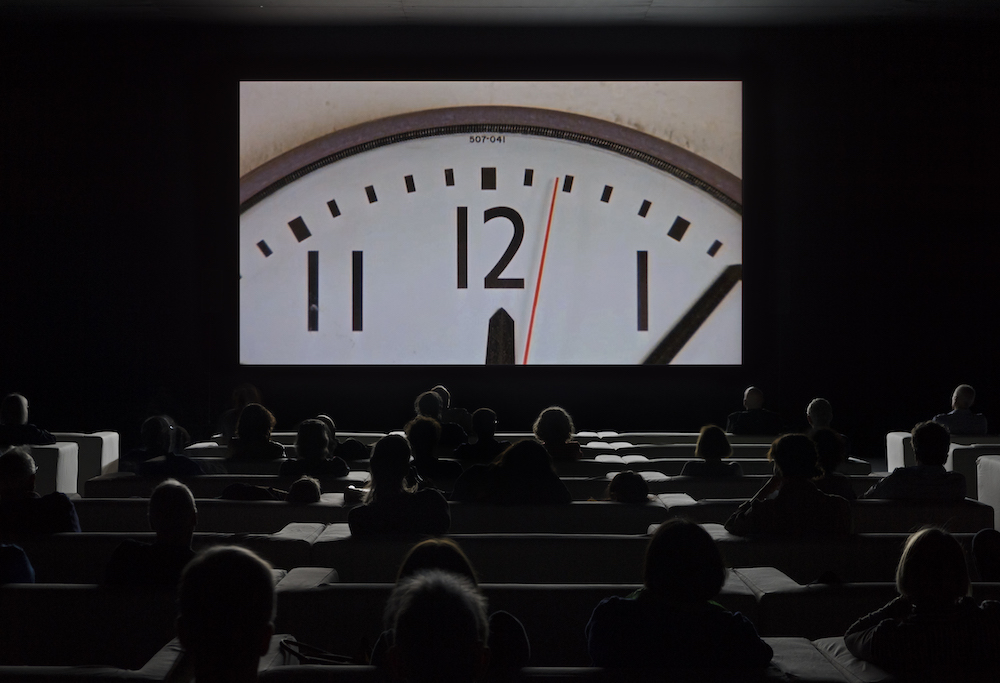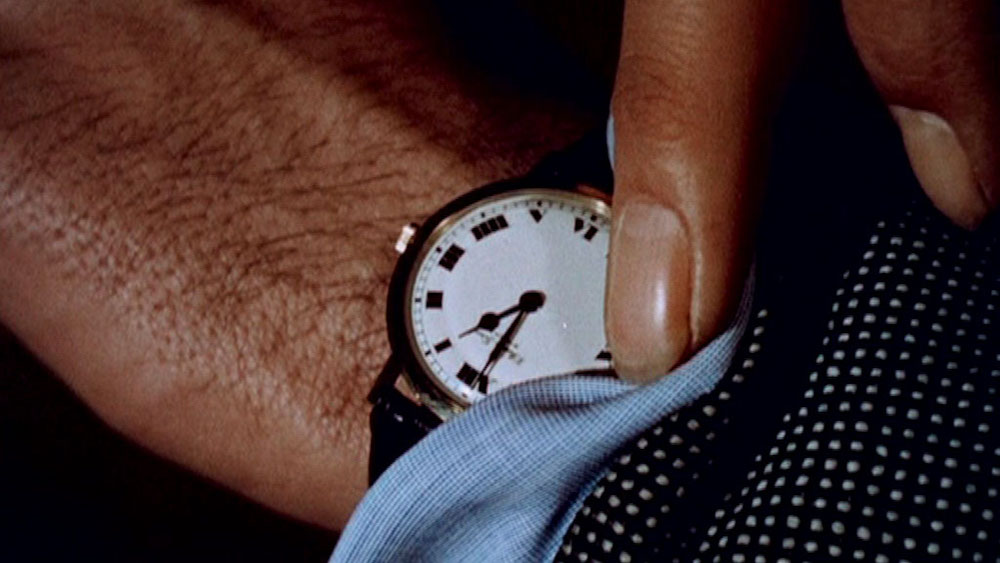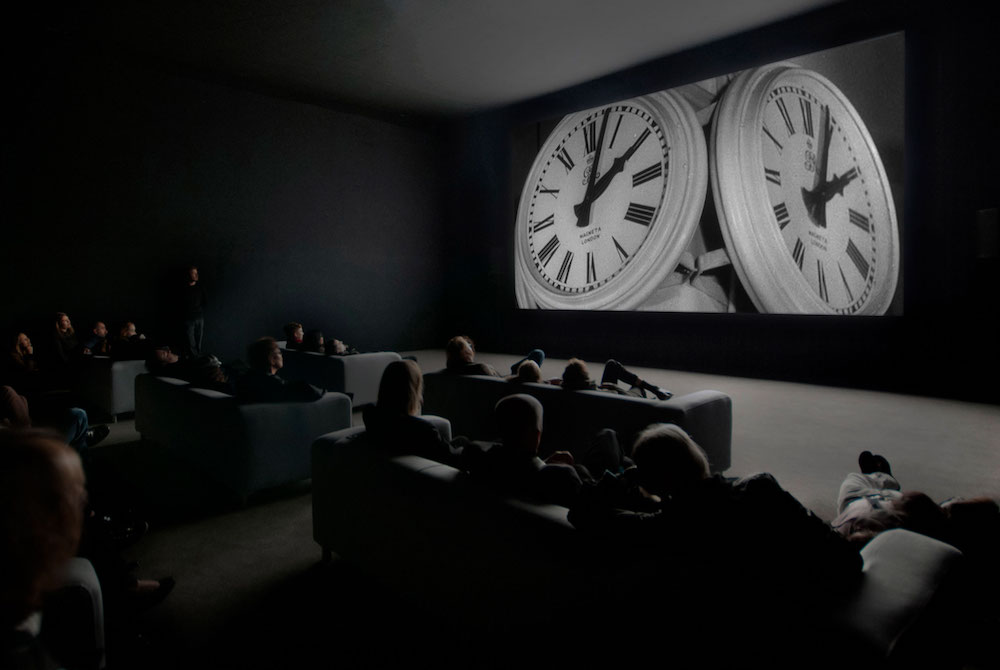Christian Marclay’s cinematic meditation on temporality and mortality continues to entrance audiences at Tate Modern

Christian Marclay’s The Clock is as hypnotising as a pendulum swinging back and forth. Mesmerising international audiences since 2010, the 24-hour video installation ingeniously cuts together over 100 years of cinema into a seamless vignette montage. Minute by minute the exact time is shown on screen – a flash of a wristwatch, Big Ben striking, the neon glow of an alarm clock – perfectly in sync with the real, local time of wherever it is screening.
Transitioning between and fusing literally hundreds of wildly different films results in a staggering production marvel, with disparate clips weaved together through deft visual and sonic editing tricks. It is not uncommon for people to wander in, sit down and become completely absorbed, ironically oblivious to the fact that hours have passed. It revels in the melodramatic and magnifies the banal, highlighting both the tedium of waiting and our obsession with time measurement and management. Simultaneously channeling our modern preoccupation with short-form content, it also harks back to the golden age of endurance cinema triple-bills, distorting and warping our attention spans and expectations as a viewer. We are naturally geared towards chronology and narrative resolution – but the latter never comes in The Clock. Instead, time moves swiftly on with irreverent urgency, indifferent to our desires and fears. The genius of Marclay’s work is that he has taken fragments of dramatic artifice and exposed a number of truths about how we live our lives and the precious, limited time we have.
Having travelled the world extensively the installation has now come back to London, the place of its birth, and is being showcased for the first time at Tate Modern. Port spoke to Fiontan Moran, Assistant Curator, about its addictive quality and powerful, flitting frames.
Why do you think The Clock has become such a sensation around the world?
Everyone can relate to a number of the scenarios in The Clock, from rushing for work, waiting for a job interview, trying to catch a train or just relaxing. It makes us aware of how our time is constructed and the poetic moments that can be found in the everyday. But also conveys the collective memory formed around film and television.
A large part of the appeal is that within the space of a few minutes, visitors see a wide range of scene, actors and emotions that are often very familiar but which are placed in a new context. While installing the piece and often seeing the same sections of film, we noticed that part of the appeal also comes from the delicate way Marclay edits all the scenes together.
What role does the banal and boredom play in the piece?
The Clock makes you aware of the everyday things that people do, which are not usually the main focus of a film. By seeing this I think viewers maybe reconsider how time is spent and can perhaps read more meaning into such moments.
How does the physical set up at the Blavatnik – sofas lined up, aping a cinema – change the viewers experience to say, standing in an art gallery?
Christian Marclay has set out that the installation should feature sofas that are spaced apart. This means that the setting is more comfortable and people can arrive and leave without disturbing other visitors like you might do in a traditional cinema. The setting also creates a sense of community where you become more conscious of how long people choose to stay in the installation.

What is the tension between cohesion and contrast, both visually and aurally?
The sound is very important to the success of the video. Marclay wasn’t interested in just fading out the soundtrack of one scene as it changed to another. Instead he worked closely with the sound designer Quentin Chiappetta to construct how the music might bleed from one clip to another, which sometimes creates an interesting contrast between what is seen and what is heard.
Do you have a favourite clip, or moment?
It’s impossible to choose a favourite clip as there are so many. Often the ones that seem to resonate are those that remind me of films that I watched when I was younger such as Hook or Desperately Seeking Susan.

What does it have to say about the social media attention span of the 21st Century, or its content e.g Youtube, Vines?
Although the vast variety of clips in The Clock can be compared to how many people view multiple screens at the same time, the emphasis on time passing means that you are forced to focus on the singular act of time passing and how it is represented in cinema and tv.
Do you think it provides any form of resolution? Does it need to?
Christian has said that there is no official beginning or end to the piece, just like a clock. Instead I think the only resolution – if you want to use that term – is a greater awareness of the multitude of activities that might be taking place across the world within the space of a few minutes, and inevitably a sense of mortality.
The Clock is being shown at the Blavatnik Building, Tate Modern, until the 20th January 2019
Check out our favourite desk and wall clocks here